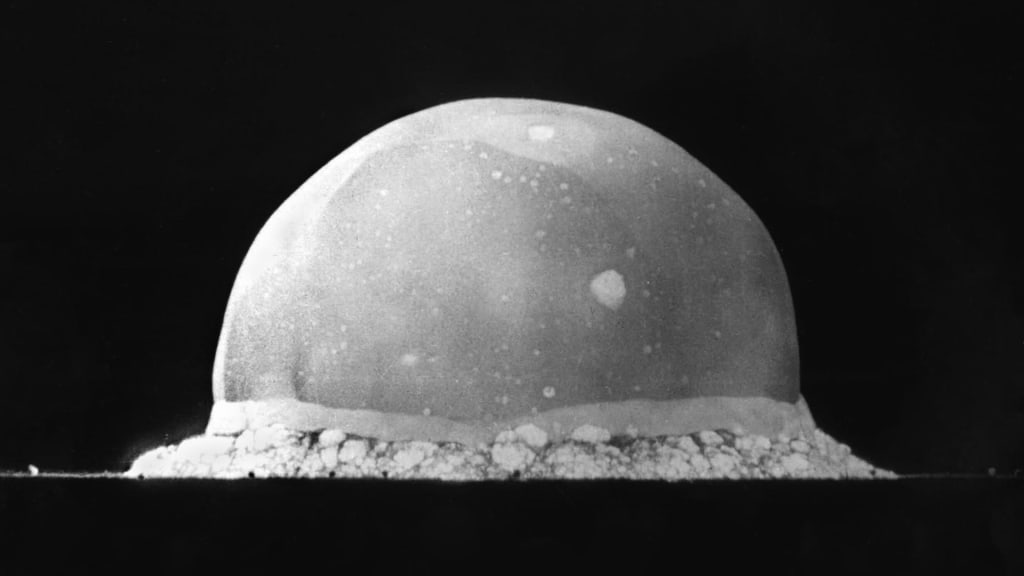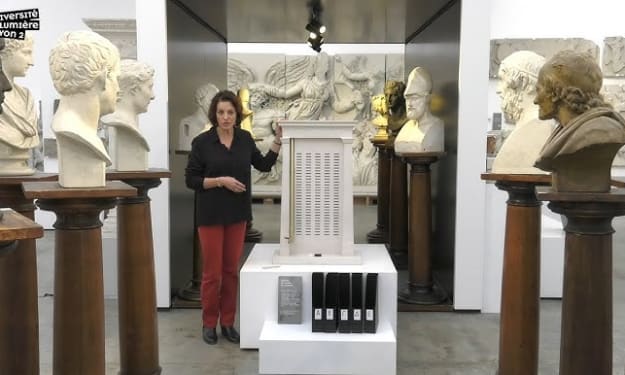OPPENHEIMER'S MYSTERIOUS CITY, MADE SENSE OF
secret city

Now I am become death.” “The destroyer of worlds.” P.O. Box 1663 was listed as a Santa Fe, New Mexico address in 1943. And over the next few years, about 300 babies... had it listed as the place of birth... on their birth certificate. Because the real location was a secret. Everything sent to that P.O. box ended up here: 33 miles from Santa Fe at a site also known... as P.O. Box 180, Project Y, and Los Alamos, New Mexico. A secret city had been built there. And it was home to a community of scientists. “Scientists of many nations.” The scientists who created the first nuclear bomb. They lived a couple hundred miles from the site where their invention would be tested. “New Mexico desert.” Trinity. How did laboratory director J. Robert Oppenheimer... end up building a town... and testing the first nuclear bomb... here? Albert Einstein sent this letter on August 2nd, 1939. He sent it to President Franklin Delano Roosevelt. Drawing from the work of physicists Enrico Fermi and Leo Szilard... Einstein warned of a nuclear chain reaction in a large mass of uranium. “The splitting of the uranium atom...” Which could lead to extremely powerful bombs of a new type. Bombs that either side might develop and use. After a couple of years of study as well as the American entry into World War II, in June 1942, the Army Chief of Staff established a temporary headquarters... at 270 Broadway in New York City. The Manhattan Project had begun. And it was called a new "Manhattan District" for the Army Corps of Engineers. This map shows contemporary boundaries for Army engineer districts. Administrative areas. The Manhattan District encompassed all these smaller districts because of its larger scope: to build an atomic weapon. Less prominent secret locations included a nuclear reactor under a University of Chicago football field... the Alabama Ordnance Works for producing heavy water... and many others. 1942 and 1943 saw the establishment of three major sites. It began with Oak Ridge, Tennessee, sometimes called Y-12. A large plant for the enrichment of uranium and production of some plutonium. Nestled between mountains, it became... “...a city where 75,000 people worked in absolute secrecy on history's most sensational secret.” Two other major locations were established in 1943. The Hanford Engineer Works in Washington state was responsible for much of the production of plutonium. The top of this water tower there read... “Silence means security.” But Hanford and Oak Ridge were nothing without the third site. The army needed a place to create the bomb. This is the Los Alamos Lament... a poem sometimes sung, about life in Los Alamos... written by technical Sergeant Ralph Gates. It begins... “I'm just a PO number.” Specific numbers vary. The third verse reads... [woman’s voice singing] “He put us on a mountain... ...outside of Santa Fe... ...where the only sign of wildlife are GI wolves at bay.” Oppenheimer, based in Berkeley... had believed that a central lab was key. While they considered Oak Ridge and Chicago as lab locations, neither was remote enough. An option near LA wasn’t isolated. One closer to Reno could be hit by heavy snows. General Leslie Groves Jr. of the Army Corps of Engineers ran the project. Oppenheimer and Groves agreed... that New Mexico offered the security of isolation... as well as familiarity, since Oppenheimer had spent time in the area. The ideal site sat on the Pajarito Plateau. It was isolated but also protected by its altitude and surrounding geography. Jemez Springs, chosen first, proved to be too difficult. The land was too difficult to acquire and the terrain was too rugged. But nearby Los Alamos was atop a table land between mesas... which made it easy to control entry and control any accidents. Much of it was on already federally-owned land as well. The only existing structure was a small school that had opened in 1935. The owners sold. The Secretary of War wrote the Secretary of Agriculture about the military necessity of acquiring the remaining federally-owned lands. The request was granted for 54,000 acres of a demolition range. Los Alamos was activated... on April 1st, 1943. P.O. Box 1663 transformed from an outdoorsy ranch school with buildings like this... into a community doing the most advanced research in the world. Roads were quickly developed, but the town was kept isolated. Population grew from 1500 people to 5700 by 1945. So rapid that hutments
were a typical type of convenience. Here you can see the wash drying by Quonset cottages. Apartment complexes were additionally accessible. These facilities blended close to offices for graphite manufacture... furthermore, the cyclotron and Van de Graaff machines. In early years, Los Alamos housed the world's best specialists. Here, Dorothy McKibbin accountable for getting new faculty, sits close to Oppenheimer. He's visiting with physicist Victor Weisskopf. Here's Enrico Fermi on a climb. Furthermore, this is Edward Teller's ID identification. He was subsequently called the dad of the nuclear bomb. The Clinical Corps colonel composed Leslie Forests that this scholarly gathering made difficulties for a tactical activity. "The enormous level of educated people... will require and look for more clinical consideration than the typical individual." Different difficulties? One-fifth of the wedded ladies became pregnant in Los Alamos... making maternity wards a need. The past and nuclear future converged. Ice was cut from adjacent lakes... also, put away in ice houses... since electric refrigerators were too difficult to even consider getting. At that point, the Bendix washer was upsetting clothing. By 1943, a grouped promotion in the St Nick Fe New Mexican was searching for one to be transported to P.O. Box 1663 for wartime work. However, social peculiarities... as differed as they were, similar to this Los Alamos band... they had one genuine reason: Building a bomb. What's more, they required a spot to test the bomb that they fabricated. This is the headquarters at Trinity site. A quickly settled central command made for testing the main nuclear bomb. The desert preparing focus north of Rice, California, was second place. Be that as it may, it wasn't sufficiently secluded or close enough to Los Alamos. Situated in the Jornada del Muerto Valley. The triumphant site was chosen with a more outrageous variant of the Los Alamos standards. Level territory to limit impact impacts. Detached, yet close enough to Los Alamos. Great climate and close by to interstates like US-85 and 380. In excess of 200 occupants settled at the camp. To start with, there was a 100 ton explosives test in May 1945. Then, at that point, they arranged the Contraption atomic gadget. What's more, on July sixteenth, 1945... they directed the test. "First give a shot of this new grandiose power was hung on the New Mexico desert." The Los Alamos Mourn was composed after that test... however, before the August bombarding of Japan. [woman singing] "I'm simply a P.O. number..." "I have no genuine address..." "Despite the fact that we were selected..." "I wonder for the best..." "dislike other people..." "Nobody understands what we do..." "So P.O. Box 1663..." "Here's to you."
About the Creator
Enjoyed the story? Support the Creator.
Subscribe for free to receive all their stories in your feed. You could also pledge your support or give them a one-off tip, letting them know you appreciate their work.





Comments
There are no comments for this story
Be the first to respond and start the conversation.